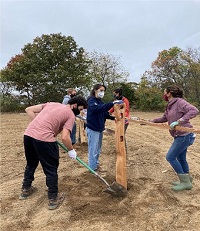Superfund Research Program
November 2021
Approximately 500,000 Native Americans live within three miles of a Superfund site. The NIEHS Superfund Research Program (SRP) has long supported community-engaged research with Native American communities to identify strategies to reduce exposures and protect their health.
To celebrate Native American Heritage Month, this article recognizes how some SRP researchers address community concerns in Tribal lands.
Empowering Youth Through Community Outreach
By connecting cultural and scientific knowledge, SRP researchers educate and engage Tribal youth in activities to address their community's environmental health concerns.

Brown SRP Center trainees and community members volunteer to clear land on the Narragansett Tribal Farm.
(Photo courtesy of the Brown SRP Center)
The Oregon State University SRP Center conducts annual Tribal Youth Campus Tours for high school students. The events allow tribal youth to learn about SRP research, environmental health, and career opportunities in science, technology, engineering, and math.
Building on a long-time partnership with the Narragansett Tribe, the Brown University SRP Center hosts community volunteering days at the Narraganset Tribal Farm and environmental field days to involve Tribal youth in environmental studies.
At the University of Arizona SRP Center, researchers are training the next generation of Navajo scientists. Through their Indigenous Food, Energy, and Water Security and Sovereignty program, the team offers Navajo youth technical and hands-on experience to gain the skills and knowledge necessary for a career in science.
Leveraging Citizen Science
Researchers at SRP Centers work closely with Native American communities to build tribal capacity to better understand and interpret data, identify exposure sources, and develop their own risk reduction recommendations.

UNM SRP Center trainees help local farmers and gardeners take environmental samples near abandoned uranium sites.
(Photo courtesy of the UNM SRP Center)
In partnership with the Pueblo of Laguna, University of New Mexico (UNM) SRP Center researchers trained citizen scientists to collect soil and plant samples to examine metal concentrations in local farms and vegetable gardens. The community-engaged study involved 30 sampling locations and 15 different families.
In response to the Gold King Mine Spill, University of Arizona SRP Center investigators initiated a citizen science project to inform Navajo communities of the potential effects on the environment and their health. The team developed YouTube videos to train community members to collect and process water and soil samples. They also created the Farming is Life program, in which Navajo farmers sampled their water, soil, and corn for arsenic and lead and received information about the levels found.
Creating Culturally Appropriate Messages
By involving tribal communities and students, SRP-funded scientists are better able to create effective strategies to communicate environmental health risks.

At the UNM SRP Center, researchers work with a local artist to turn complex environmental health concepts into meaningful images for Native American communities. Together, they are using tribal symbolism to create intricate artwork to communicate how exposure to metals can harm people's health.
SRP researchers also contributed their expertise to create outreach materials in response to the COVID-19 pandemic. For example, the University of Arizona created outreach materials in Navajo, and UNM developed culturally appropriate posters to communicate the importance of social distancing and mask-wearing.


